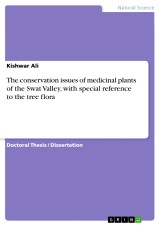Details

The conservation issues of medicinal plants of the Swat Valley, with special reference to the tree flora
1. Auflage
|
CHF 42.00 |
|
| Verlag: | Grin Verlag |
| Format: | |
| Veröffentl.: | 14.09.2017 |
| ISBN/EAN: | 9783668524071 |
| Sprache: | englisch |
| Anzahl Seiten: | 496 |
Dieses eBook erhalten Sie ohne Kopierschutz.
Beschreibungen
Doctoral Thesis / Dissertation from the year 2011 in the subject Biology - Botany, grade: A, University of Reading, course: Doctorate, language: English, abstract: This study has revealed that climate change will significantly affect adversely the distribution of some of the most important medicinal, ecological and economically important tree species of the Valley. This change will not only modify the landscape but the whole socio-ecological system of the area. Plants like Abies pindrow, Pinus wallichiana, Cedrus deodara and Pinus roxburghii will be directly affected by the a2a climate change scenario for the year 2080.
This study also predicts the trend in altitudinal movement of species as a consequence of climate change; as the northern parts of the Valley provide high altitudes of significantly colder environment than the southern parts. The ethno-cultural study revealed that the people of the area have a well established ethnomedicinal culture in place and some plants could be at high risk of extinction from the unsustainable practices of plant collection. The core plants of the ethno-culture were Berberis lyceum in five calculated indices: Salience Index (SI), Relative Importance Index (RII), Cultural Value Index (CVI), Cultural Importance Index (CII), and Ali’s Conservation Priority Index (CPI); Skimmia laureola ranked second in the SI, fifth in the RII, seventh in CVI, third in CII, but ninth in CPI, and Mentha longifolia ranked third in the SI, and RII.
Detailed biodiversity analysis has revealed that different parts of the Valley have different biodiversity index values. Some locations like location 1(Landakay, Kota, Aboha and Barikot), Location 4 (Aqba and Saidu Sharif) and Location 7(Fateh Pur), have high rankings in various biodiversity indices and further GIS analysis has identified present and future biodiversity hotspots. Digital Elevation Models (DEMs), extrapolated in the GIS, have revealed species preferences for certain altitudinal zones and the Ordination Analyses confirmed plant-plant and plant-location interaction responses in the area. It is concluded that a real threat to the biodiversity, forests and MAPs exists and only careful policy planning can rescue the area from permanent biodiversity loss in the Swat district.
The Swat district has very varied vegetation structure due to the great geophysical variation. There is a great potential for the Valley to act as an economic hub for Pakistan in the Medicinal and Aromatic Plants (MAPs) industry. However, the forest ecosystem services of the Valley are under continuous threat from the direct and indirect anthropogenic stresses.
This study also predicts the trend in altitudinal movement of species as a consequence of climate change; as the northern parts of the Valley provide high altitudes of significantly colder environment than the southern parts. The ethno-cultural study revealed that the people of the area have a well established ethnomedicinal culture in place and some plants could be at high risk of extinction from the unsustainable practices of plant collection. The core plants of the ethno-culture were Berberis lyceum in five calculated indices: Salience Index (SI), Relative Importance Index (RII), Cultural Value Index (CVI), Cultural Importance Index (CII), and Ali’s Conservation Priority Index (CPI); Skimmia laureola ranked second in the SI, fifth in the RII, seventh in CVI, third in CII, but ninth in CPI, and Mentha longifolia ranked third in the SI, and RII.
Detailed biodiversity analysis has revealed that different parts of the Valley have different biodiversity index values. Some locations like location 1(Landakay, Kota, Aboha and Barikot), Location 4 (Aqba and Saidu Sharif) and Location 7(Fateh Pur), have high rankings in various biodiversity indices and further GIS analysis has identified present and future biodiversity hotspots. Digital Elevation Models (DEMs), extrapolated in the GIS, have revealed species preferences for certain altitudinal zones and the Ordination Analyses confirmed plant-plant and plant-location interaction responses in the area. It is concluded that a real threat to the biodiversity, forests and MAPs exists and only careful policy planning can rescue the area from permanent biodiversity loss in the Swat district.
The Swat district has very varied vegetation structure due to the great geophysical variation. There is a great potential for the Valley to act as an economic hub for Pakistan in the Medicinal and Aromatic Plants (MAPs) industry. However, the forest ecosystem services of the Valley are under continuous threat from the direct and indirect anthropogenic stresses.
Diese Produkte könnten Sie auch interessieren:

Handbook of Poisonous and Injurious Plants

von: Lewis S. Nelson, L.R. Goldfrank, Andrew Weil, Richard D. Shih, Michael J. Balick

CHF 142.00















